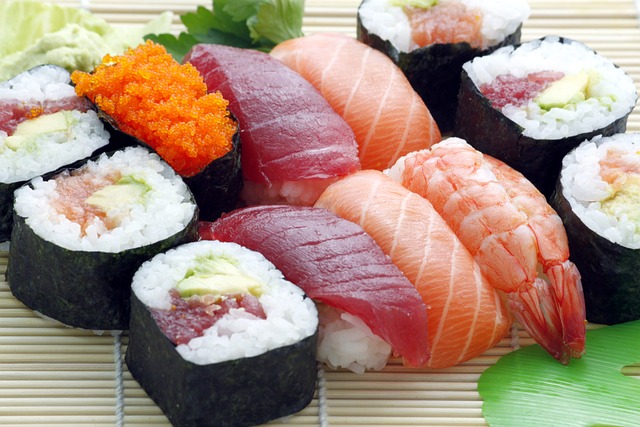“The Japanese diet is the iPod of food,” says Naomi Moriyama, co-author of Japanese Women Don’t Get Old or Fat: Secrets of My Mother’s Tokyo Kitchen, “it concentrates the magnificent energy of food into a compact and pleasurable size.”
In Japan, meals are presented on individual small plates and bowls as opposed to one large plate. Moriyama explains that diners sample various dishes in rotation. A key strategy for healthy eating and weight loss is to serve meals in smaller portions. Studies indicate that we consume larger quantities when presented with more food, regardless of our hunger levels or intended consumption.
According to a report by scientists from the University of Illinois, Urbana-Champaign, individuals consume nearly 45% more food when presented with larger portions.
In a recent survey conducted by the American Institute for Cancer Research (AICR), almost 70% of respondents attributed the amount of food they placed on their plates to the portion size they were used to consuming.
There’s both negative and positive news. The negative news is that it confirms our tendency to mindlessly consume food. The good news, however, is that we can alter our food intake by gradually getting used to eating smaller portions. One way to do this is to substitute larger dinner plates with smaller ones, such as dessert or salad plates. As a result, we’ll consume less food without realizing it, as the plate will appear just as full.
Lisa R. Young, PhD, RD, author of The Portion Teller Plan, suggests experimenting with serving food in measuring cups for about a week to help you get accustomed to the appropriate amount of food you should be consuming. According to Young, it is unnecessary to reduce all your portion sizes, except for those of high-calorie and high-fat foods.
A foundation based on rice.
According to Moriyama’s statements to WebMD, the Japanese diet comprises of significant quantities of rice; approximately six times more than the typical American diet. Rice, even at breakfast, is served in a small bowl accompanying almost every meal.
Rice, which is a complex carbohydrate with low fat content, has the ability to satiate you with fewer calories. As a result, there is less space in your stomach for unhealthy foods like packaged pastries and cookies, which may contain trans fats that are harmful to the heart. To obtain further health advantages, try serving rice the Japanese way by cooking and consuming it without any butter or oil.
A sandwich full of vegetables.
According to Moriyama, Japan has a strong obsession with vegetables. A survey conducted among Japanese women revealed that the dish they enjoyed cooking the most for their families was mixed vegetables cooked in a flavorful broth.
The Japanese cuisine incorporates a variety of vegetables including red bell peppers, green beans, zucchini, eggplant, onions, burdock, tomatoes, green peppers, lettuce, carrots, spinach, bamboo shoots, beets, lotus root, turnips, daikon (or giant white radish), shiitake mushrooms, sweet potatoes, and seaweed (or sea vegetables) namely kombu, nori, and wakame.
In one meal, there could be as many as four or five diverse vegetable types served, and it is not unusual to have soup or salad for breakfast. Vegetables are cooked using methods such as being simmered in a flavored broth, stir-fried in a small amount of canola oil, or steamed lightly – all techniques that preserve the highest amount of nutrients.
An excellent capture.
Moriyama informs WebMD that fish, particularly oily fish such as the beloved Japanese options of salmon and fresh tuna, mackerel, sardines, and herring, provide abundant omega-3 fatty acids that are recognized for their advantages in heart health and enhancing mood.
Despite having a population of only 2% of the world’s total, Japan consumes 10% of global fish supply. As a result, the consumption of red meat, which contains harmful saturated fat leading to obesity and heart disease if consumed excessively, is lower compared to other countries due to Japan’s emphasis on fish consumption.
Good soy.
According to Moriyama, soy products such as tofu and edamame beans are a healthy source of protein as they contain little or no saturated fat, making them a preferable alternative to red meat, as long as they are consumed in moderation. In Japanese cuisine, it is common to have more than one dish made from soy, such as miso soup, which is made from fermented soybeans, and pieces of tofu.
There is a connection between various health benefits and the conventional Japanese diet.
Rich in nutrients and beneficial compounds
The Japanese diet that is customary is abundant in several nutrients such as fiber, calcium, potassium, magnesium, iron, as well as vitamins A, C, and E.
The inclusion of vegetables in this diet increases its nutrient density and they are commonly prepared in dashi, a broth made from dried fish and sea vegetables. This method of cooking reduces their size and improves their taste, facilitating consumption of large quantities.
Seaweed and green tea, both of which are excellent sources of antioxidants, can be found in abundant quantities in this diet. These compounds are advantageous in safeguarding the body from cellular harm and ailments.
Furthermore, this diet encompasses numerous dishes incorporating fish and seaweed, which are rich in long-chain omega-3 fats that support the health of the brain, eyes, and heart.
May improve your digestion
Foods such as seaweed, soybeans, fruits, and vegetables are abundant sources of fiber, a substance that assists with digestion. Insoluble fiber facilitates the movement of food through the intestinal tract and increases the volume of stool, decreasing the likelihood of experiencing constipation.
These edibles also feature soluble fiber that nourishes the advantageous microbes residing in your intestinal tract and diminishes the area accessible for detrimental bacteria to thrive.
Soluble fibers are the food source for gut bacteria, resulting in the production of short-chain fatty acids (SCFAs), known to alleviate inflammation and symptoms associated with irritable bowel syndrome (IBS), Crohn’s disease, and ulcerative colitis.
Additionally, the consumption of pickled fruits and vegetables as part of this dietary regimen provides a rich reservoir of probiotics, which act as advantageous microbes that foster gastrointestinal wellbeing and alleviate symptoms such as flatulence, abdominal distension, irregular bowel movement, and bowel looseness.
May promote a healthy weight
The customary Japanese cuisine is abundant in vegetables, features modest servings, and inherently contains minimal amounts of added sugar and fat, which ultimately result in a reduced calorie intake. Furthermore, the Japanese society promotes the habit of stopping eating when feeling 80% full, which prevents overindulgence and could potentially lead to a caloric deficit, essential for weight loss.
Moreover, studies indicate that consuming vegetables high in fiber, soy-based products, and soups that are commonly included in the customary Japanese cuisine can decrease cravings and increase satiety, thus supporting weight management.
According to evidence, switching between courses like in typical Japanese dining may potentially decrease the overall meal consumption.
May protect against chronic diseases
Consuming a traditional Japanese diet with an abundance of fish, seaweed, green tea, soy, fruits, and vegetables and a low intake of added sugar, fat, and animal protein may offer protection against conditions such as heart disease and type 2 diabetes. These factors are believed to contribute to the diet’s potential health benefits.
Despite their high consumption of salt, which is known to increase the risk of heart disease, the Japanese population surprisingly has a low incidence of heart disease.
Additionally, 91% of 33 men who adhered to the conventional Japanese diet for a period of six weeks demonstrated noteworthy decreases in risk factors associated with type 2 diabetes, such as elevated levels of LDL (harmful) cholesterol and excess body weight.
Moreover, consuming a significant amount of green tea as recommended by this diet can potentially safeguard against Alzheimer’s disease, Parkinson’s disease, as well as some forms of cancer.
May help you live longer
The traditional Japanese diet is believed by many experts to be the reason why Japan has one of the highest life expectancies in the world.
The island of Okinawa in Japan is categorized as a Blue Zone for its remarkably extended lifespan. It’s significant to note that the Okinawa diet emphasizes sweet potatoes while incorporating less rice and fish compared to the customary Japanese diet.
Over the course of 15 years, more than 75,000 Japanese individuals were studied, and it was concluded that those who adhered to the traditional Japanese diet had a significantly lower risk of early mortality, up to 15% less than those who consumed a diet that was Westernized.
The traditional Japanese diet’s emphasis on whole, minimally processed foods and low amount of added fat and sugar has been connected by experts to the prolonged lifespan of the Japanese. This nutrient-rich diet may assist in digestion, weight loss, and the reduction of chronic illness risk.
The following foods are abundant in the traditional Japanese diet:
- Fish and seafood. All types of fish and seafood can be included. These can be steamed, baked, grilled, or raw — as is the case with sushi and sashimi.
- Soy foods. The most common are edamame, tofu, miso, soy sauce, tamari, and natto.
- Fruit and vegetables. Usually, fruits are eaten raw or pickled while vegetables are steamed, sautéed, pickled, simmered in broth, or added to soups.
- Seaweed. Sea vegetables are a big part of the traditional Japanese diet. They’re usually eaten raw or dried.
- Tempura. This light dough is made by mixing wheat flour with iced or sparkling water. It serves as a batter for deep-fried seafood and vegetables.
- Rice or noodles. Steamed rice is a staple in a traditional Japanese diet. Other popular options include soba, ramen, or udon noodles served chilled or in a hot broth.
- Beverages. Hot green tea and cold barley tea are the main beverages, though beer and sake may be served with dinner.
Although small quantities of red meat, poultry, eggs, and dairy products can be included, they are not a significant component of the traditional Japanese diet. The emphasis is on consuming whole or minimally processed foods such as fish, seafood, seaweed, rice, soy, fruits, and vegetables, with small amounts of other animal products.
The Japanese diet that is customary emphasizes the reduction in consumption of the following foods:
- Dairy: butter, milk, cheese, yogurt, ice cream, etc.
- Red meat and poultry: beef, pork, chicken, duck, etc.
- Eggs: boiled, fried, as an omelet, etc.
- Excess fats, oils, and sauces: margarine, cooking oils, dressings, fat-rich sauces, etc.
- Baked goods: bread, pita, tortillas, croissants, pie, brownies, muffins, etc.
- Processed or sugary foods: breakfast cereals, granola bars, candy, soft drinks, etc.
In addition, snack options are rare when following this diet, resulting in a reduced availability of favored snacks such as chips, crackers, trail mix and popcorn. However, desserts can still form part of a traditional Japanese diet without the use of added sugars, using natural ingredients such as matcha, red bean paste or fruit.
In the traditional Japanese diet, snacks are not included and there’s a natural inclination towards minimal consumption of dairy, red meat, poultry, baked goods, and foods that are sugary or processed.
Whole, nutrient-dense, seasonal foods that are minimally processed are the mainstays of the traditional Japanese diet. The diet is loaded with seafood, vegetables, and fruits, but limits consumption of meat, snacks, and dairy. Embracing this diet could aid digestion, support weight management, reduce the risk of diseases, and increase lifespan.
There are numerous books available on the traditional Japanese diet which you can explore to gain further knowledge. While searching for options, it’s advisable to search for books that concentrate on whole foods and do not include Westernized recipes.



